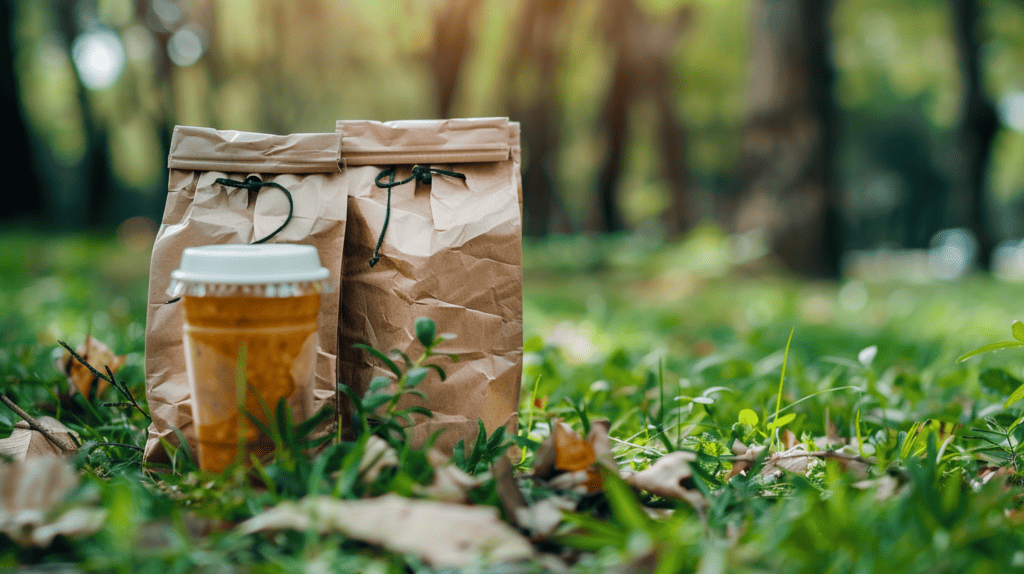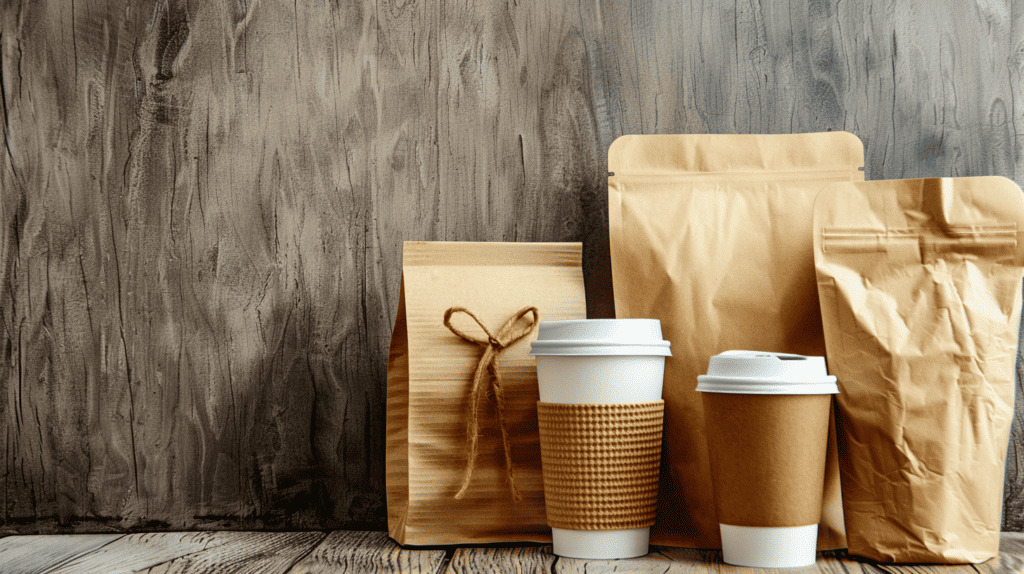Recent studies show a prominent trend with 45% of American respondents now opting to avoid plastic whenever they can. This is a clear sign of a shift towards more environmentally responsible consumption patterns. Coupling this with stringent regulatory landscapes like the EU Plastic Directive signals a rising interest in sustainable food packaging. These legislative measures aim to enforce the use of recycled materials in plastic bottles, further enhancing environmental sustainability.
Modern consumers aren’t just environmentally aware; they are proactively seeking safer, visually appealing packaging that meets stringent environmental standards. The emergence of eco-marketing and extensive dialogue around packaging’s role in both marketing and environmental sustainability reflects this growing demand. As I delve into this intriguing discourse, I am keen on uncovering the determinants and implications of these shifting trends in consumer attitudes towards biodegradable items and sustainable food packaging.
Key Takeaways
- Consumer behavior is increasingly guided by concerns for environmental sustainability.
- Biodegradable plastic and sustainable food packaging have become key interests among consumers.
- Legal regulations such as the EU Plastic Directive support the move towards recycled materials in plastic bottles.
- Evolving consumption patterns show a shift towards biodegradable items and efforts are ramping up in eco-marketing.
- Consumers are demanding packaging that is both safe and aesthetically pleasing while meeting environmental standards.
- A deeper exploration into the discourse around packaging can help unravel the factors driving these shifts in consumer attitudes.
Exploring the Shift in Consumer Perceptions of Packaging Sustainability
The conversation around sustainability has considerably deepened in recent years, reflecting a pronounced shift in consumer perceptions of packaging. Indeed, products that converge lifestyle choices and environmental concerns are becoming increasingly sought after.
Interestingly, a significant segment of consumers in Poland is now rallying for a ban on plastic food packaging. Conversely, they express a preference for paper or carton alternatives. This trend, I believe, has its roots in the escalating global awareness about environmental preservation and the urgent need for sustainable packaging.
Despite several brands exploiting the trend through superficial greenwashing practices, genuine eco-conscious marketing is on the rise. Green consumers are becoming noticeably discerning and are influenced by a multitude of factors, including widespread eco-anxiety.
Unsurprisingly, the preference is now leaning towards biodegradable and compostable packaging options. The reasons behind this change provide valuable insight into the current consumer demand and its influence on packaging choices. Here, I would like to focus on a few dominant factors.
| Factors influencing sustainable choices | How it influences consumer demand |
|---|---|
| Eco-marketing | Effective Eco-marketing strategies persuade consumers to choose products that are packaged sustainably. |
| Effort to Identify Biodegradable Packaging | Increased consumer understanding of sustainable packaging materials augments demand for biodegradable options. |
| Role of marketing communications | Clear communication about a product’s sustainability credentials enhances consumers’ trust and fosters a green consumer culture. |
Society’s focus is now gradually shifting towards the lifecycle of packaging materials. As both advocates and consumers, the push for sustainability and waste reduction is stronger than ever. Equally, brands are being pressed for greater transparency and accountability in their environmental claims. A profound change is on the horizon, and understanding this shift is key to maintaining relevance in a rapidly evolving marketplace.
Factors Influencing Consumer Attitudes Towards Biodegradable Items

In the evolving landscape of sustainable consumption, various factors and trends significantly shape consumer attitudes towards biodegradable items and their purchasing decisions. Let’s explore them in detail.
Impact of Environmental Awareness on Purchasing Decisions
Heightened awareness regarding environmental sustainability has seen a substantial increase in recent years, with many Americans becoming more concerned about climate change and its resulting environmental impact. This growing concern is reflected in their purchasing decisions, with consumer movements advocating for more biodegradable and eco-friendly products. The demand for sustainable products has increased and consequently driven the shift towards more sustainable packaging solutions.
The Role of Eco-Anxiety in Shaping Consumer Behavior
It’s worth noticing the role of eco-anxiety in shaping consumer behavior, a phenomenon that is on the rise. With the omnipresence of environmental messages, often negatively framed, it’s observed that consumers are increasingly intending to make pro-environmental choices. This eco-anxiety and environmental depression have influenced the preference towards biodegradable items. In essence, the purchase of these items is perceived as an action towards alleviating their environmental worry.
Understanding Biodegradability and Consumer Knowledge Gaps
While eco-anxiety motivates sustainable consumption, it’s important to shed light on the knowledge gaps among consumers. Understanding biodegradability and sustainable materials is still a prevalent need, and consumer knowledge must suffice to make informed decisions. Despite their concern for these environmental issues, consumers often struggle to identify biodegradable packaging materials accurately. Therefore, promoting further education and clearer labeling can promote understanding and pave the way for informed sustainable choices.
Packaging Materials as a Marketing Lever in Consumer Products
In today’s rapidly changing market, packaging materials no longer serve solely as a means to protect and encapsulate a product. With mounting environmental concerns and shifting consumer behaviors, these materials have evolved into powerful marketing communication tools.
Companies striving to echo the values of environmentally conscious consumers are increasingly moving towards biodegradable packaging. This helps establish a brand’s eco-conscious credentials and bolsters its appeal to specific consumer groups.
The materials used for packaging have the power to set products apart and evoke positive associations, thereby influencing purchase decisions. Even the choice of color, design, and texture used for packaging can align with a brand’s sustainability ethos and communicate its brand values effectively.
Additionally, many companies are realizing the immense benefits of using such materials to improve their brand reputation. For a company that prides itself on sustainability, the use of biodegradable or eco-friendly packaging sends a clear, cohesive message to its customer base, enhancing its brand image while playing a crucial role in its marketing strategy.
The role of eco-friendly packaging as a marketing lever is undeniable. The strategic use of these materials can greatly influence consumer preferences, sway purchase decisions, and help build an enviable brand reputation. Thus, packaging materials are not a mere logistical necessity but a cornerstone of effective marketing communication.
Consumer Preferences and the Willingness to Adopt Biodegradable Packaging
As we continue to step deeper into an era of environmental awareness, consumers are showing a growing willingness to pay more for sustainable packaging. However, an array of factors influence this openness, including perceptions of price, quality, convenience, and environmental impact.

Assessing Willingness to Pay for Sustainable Packaging
The trend towards sustainability has triggered a shift in consumers’ willingness to pay for eco-friendly products. From food items encased in biodegradable polymers to personal care products wearing bio-based jackets, consumers are gradually acclimatising to paying a premium for environmental friendliness. In fact, research reveals a spectrum of readiness to embrace this cost, ranging from those willing to pay a slight increase to those ready to foot a sizeable premium over standard prices.
Perceived Value of Biodegradable vs. Conventional Packaging
Shifting the focus onto consumer perceptions, it’s clear that biodegradable packaging is being viewed in a more positive light than its conventional counterparts. Amid growing concerns around plastic pollution and environmental degradation, consumers are transitioning towards packaging options made from renewable, bio-based materials, thereby consciously making more sustainable food packaging choices. The perceived value of such packaging as being more eco-friendly and responsible is proving to be a powerful motivator in this shift.
Consumer Demand for Packaging Transparency and Labelling
Amidst the urge to go green, a stark need for transparency and more accurate labeling about the sustainability of packaging is surfacing. It appears that consumers are in demand of clear and honest communication on packaging to help them make sustainable choices easier. An increasing call for clarity extends to providing accurate information about the types of materials used, their biodegradability, and recyclability status. The desire for an assurance that they are indeed choosing environmentally friendly packaging is evident amongst consumers.
Consumer Misconceptions and the Need for Accurate Information
In the evolving conversation around environmental sustainability, it is evident that consumers, although keen on adopting sustainable practices, face a distinct challenge. This challenge, in large part, stems from widespread consumer misconceptions about green products, in particular, sustainable packaging materials.
image that lays out the common misconceptions often clouding consumer judgment depicts the dire need to clarify the accurate information regarding various packaging materials.
This is in line with mounting evidence showing consumers leaning towards plant-based and compostable packaging, however, their understanding of these options remains limited. The complexity behind the environmental claims and standards associated with these materials is often understated, creating a distorted perception of their true sustainability credentials.
Understanding sustainable packaging goes beyond deciphering labels. It involves unpacking the lifecycle of the packaging, from raw material sourcing, production processes, potential for recycling, or composting, to its eventual environmental impact.
To help address these misconceptions, businesses must provide transparent, easy-to-understand information about their products and packaging. This may include details about the materials used, their sourcing, potential for reuse or recycling, and their environmental impact. In fact, such information is not just beneficial for consumers but also holds the potential to elevate a brand’s reputation for transparency and environmental responsibility.
Ultimately, the journey towards environmental sustainability is a shared pursuit involving businesses, consumers, and regulators. Each plays a critical role in fostering a better understanding of green products and advancing eco-conscious consumption practices. As we tackle the widespread misconceptions, the pathway to a greener future becomes increasingly clear.
The Post-Pandemic Perspective: Sustainability Sentiments in Flux

In the wake of the COVID-19 pandemic, consumer attitudes towards the environment and sustainability have seen substantial changes. Notwithstanding the perennial concerns about price, quality, and convenience, post-pandemic consumer attitudes reveal a burgeoning demographic that places significant importance on environmental impact.
Shifts in Consumer Attitudes Post-COVID-19
COVID-19 brought hygiene and food safety to the forefront of consumer consciousness, prompting a noticeable shift towards packaging strategies that prioritize these aspects. Moreover, the importance of shelf life has received a marked upswing in consumer attention, elucidating the necessity of packaging that ensures the longevity of products. Additionally, the trend of sustainable packaging has secured a foothold among numerous consumers as a crucial factor in their purchasing decisions.
Adapting Sustainable Packaging Strategies for an Uncertain Future
In these uncertain times, characterized by unpredictability and volatility, the ability to adapt is key. Sustainable packaging strategies now need to reflect the changeable conditions that consumers and companies navigate. A recent global survey underlines the importance of a customized approach to packaging, indicating that packaging sustainability plays a pivotal role for a significant segment of the market, despite not being the primary concern for all consumers.
Consumers’ Adaptation to New Norms in Shopping and Packaging Preferences
The growth of online shopping in response to the pandemic has sparked a shift in preferences regarding product appearance and packaging. Consumers are adapting to new norms, prioritizing product longevity, waste minimization and transparent brands offering recyclable products. While the visual appeal of product packaging has seen a decrease in its influence over purchasing decisions, considerations such as recyclability and sustainability have gained precedence, marking a significant change in consumer behavior post-pandemic.
| Pre-Pandemic Preferences | Post-Pandemic Preferences |
|---|---|
| Product appearance | Sustainability of packaging |
| Price and quality | Hygiene and food safety |
| Convenience | Product longevity and waste minimization |
Demographic Divergence in Consumer Attitudes Towards Biodegradable Items
As we look to comprehend the intricacies of better
consumer attitudes towards biodegradable items,
it becomes indispensable to account for the elements that influence these tendencies, notably the demographic divergence.

Analyzing diverse consumer groups reveals that generational differences strongly sway viewpoints on environmental factors like sustainability and biodegradability. Younger generations, manifestly millennials and Gen Z, are displaying higher environmental consciousness compared to baby boomers and older generations.
Younger generations’ growing insistence on sustainability is often reflected in their purchasing decisions. These individuals are more inclined to buy from brands that emphasize environmentally-friendly initiatives and use biodegradable packaging.
Equally vital when isolating the factors influencing attitudes towards biodegradable items is the difference in urban vs. rural populations. Typically, urban dwellers show a stronger inclination towards sustainable habits and eco-friendly products than their rural counterparts.
| Demographics | Attitudes Towards Biodegradable Items | Environmental Consciousness |
|---|---|---|
| Millennials & Gen Z | High | High |
| Baby Boomers & Older Generations | Lower | Variable |
| Urban Populations | High | High |
| Rural Populations | Variable | Lower |
These divergences in attitudes within different demographics are not merely intriguing insights. They represent an essential understanding for brands. By tailoring their marketing strategies to the environmental expectations and preferences of their target demographic, companies can better connect with their audience, inspire positive change, and drive a stronger impact.
Educational Approaches to Strengthening Biodegradable Packaging Advocacy
In this era of increasing ecological consciousness, it’s vital to equip consumers with accurate knowledge to make sustainable choices. Effective labelling, robust community engagement, and innovative utilization of digital platforms can collectively strengthen advocacy for biodegradable packaging and promote environmentally friendly behavior. Let’s delve into these approaches.
Implementing Effective Labelling to Clarify Biodegradable Claims
To create an eco-conscious lifestyle and meet consumer expectations, it becomes imperative to communicate clear and accurate information about products. Effective labelling, particularly, plays a significant role in debarring dubious biodegradable claims and delivering transparent information. This will facilitate consumers to make informed decisions that align with their preference for sustainable behavior and environmentally friendly packaging. Clear, eco-friendly labelling thus acts as a catapult for sustainable choices.
Community Engagement and the Role of Social Proof in Consumer Education
Social networks and local communities can serve as powerful instruments for promoting sustainable choices. To achieve sustainability advocacy, community engagement becomes crucial. It provides social proof that validates and reinforces pro-environmental actions. When consumers see their peers adopting a particular behavior, they’re more likely to follow, which lends credence to the power of community influence. This local-level impact can accelerate the adoption of environmentally friendly behaviors and products, fostering a broad shift toward sustainability.
Leveraging Digital Platforms for Eco-Marketing and Awareness Campaigns
Digital platforms, in this technologically advanced era, cater to a sizeable number of digitally empowered consumers. Brands can exploit these avenues to disseminate information on biodegradable packaging, present insights on sustainability, and directly guide consumers toward an eco-conscious lifestyle. The strategic use of eco-marketing tactics and awareness campaigns can educate consumers and inspire a shift in their behavior. This method ultimately forms the cornerstone for effective consumer education and advocacy for biodegradable and eco-friendly products.
Conclusion on Consumer Attitudes Towards Biodegradable Items
In conclusion, multiple factors significantly shape consumer attitudes towards biodegradable items and sustainable food packaging. Key among these include environmental awareness, eco-anxiety, and differing demographic factors. We are witnessing an evident shift towards more sustainable packaging; however, this transition is an ongoing journey. Continual education, accurate labeling, and effective eco-marketing strategies are integral to these changes.
Furthermore, as consumers increasingly align their purchasing decisions with their environmental concerns, there’s a compelling demand for companies to offer eco-friendly product options. These efforts, necessitated by environmental sustainability concerns, need to be supported by transparent, factual information, demonstrating and validating their ecological credentials.
Addressing popular consumer misconceptions about biodegradable plastic and sustainable packaging, improving the clarity of product labeling, and harnessing the power of digital channels for brand engagement and consumer education altogether form a comprehensive strategy. Such coordinated efforts are the key to fostering an environmentally sustainable approach to packaging within the consumer market. Thus, we inch closer to realizing the vision of a circular economy.
FAQ on Food Packaging
Q: What data availability is there on attitudes toward biodegradable items and food packaging?
A: There is an increasing amount of data available on attitudes toward biodegradable items and food packaging. This covers a wide range of areas including consumer preferences, the level of awareness of the environmental impact of packaging waste, willingness-to-pay for food packaging alternatives, and the impact of green packaging initiatives. These datasets help us to understand changing consumer attitudes and behaviors.
Q: Are consumers aware of the environmental impact of single-use plastic packaging?
A: Yes, there is data that indicates a growing consumer awareness of the impact of single-use plastic packaging. Many are pushing for improvement in waste management and are changing their behaviors as a result, opting for bio-based and biodegradable alternatives.
Q: Does life cycle assessment data indicate that bioplastic products are more environmentally friendly than conventional plastic products?
A: Life cycle assessment data typically considers every aspect of a product’s life, from production to disposal. Research has shown that biodegradable bioplastics and bio-based products generally have a less harmful environmental impact than conventional plastic, though exact figures may vary depending on specific circumstances.
Q: How consumers perceive the advantage of bio-based and biodegradable packaging over traditional plastic packaging?
A: Consumers may perceive bio-based and biodegradable packaging as an advantageous alternative to conventional plastic due to its greener characteristics. They understand that this packaging, unlike traditional plastic, can degrade naturally over time and cause less harm to the environment.
Q: What are consumers’ attitudes towards different packaging materials?
A: Consumers have varying attitudes towards different packaging materials, with a growing preference for green, biodegradable options. Data indicates that consumers show positive attitudes towards bio-based products because of their lower environmental impact, and are often willing to pay a premium for these products.
Q: How is plastic packaging affecting consumer choice?
A: The prevalence of plastic packaging is beginning to influence consumer choices, as consumers are increasingly looking for alternatives. With rising environmental concerns, many consumers are avoiding food products in plastic and are instead opting for items with biodegradable packaging.
Q: What is the impact of the data availability about the life cycle of plastic on consumers’ attitudes towards plastic?
A: The data availability about the life cycle of plastic products has highlighted the environmental impact of plastic waste, this is, in turn, influencing consumers’ attitudes towards plastic. It’s causing many to seek out alternatives and showcase positive attitudes towards products with environmentally friendly packaging.
Q: Are consumers willing to pay more for biodegradable items?
A: Yes, data shows that there is a willingness-to-pay among consumers for alternatives to traditional plastic packaging. Many consumers perceive these options as a worthwhile investment for the future of the environment.
Q: Are there any three products that consumers have shown positive attitudes toward their biodegradable packaging?
A: Yes, there are several products where consumers have shown positive attitudes towards biodegradable packaging. These typically include everyday items like food products, bottled beverages, and personal care items. The exact products may vary depending on the study or data set used.
Q: What impact does packaging waste have on changing consumer attitudes towards plastic and biodegradable items?
A: Packaging waste has a significant impact on changing consumer attitudes. As they become more aware of the scale of plastic waste and its environmental consequences, many consumers are adjusting their attitudes and buying behaviors, showing preference towards bio-based and biodegradable items over those packaged in traditional plastic.





Leave a Reply